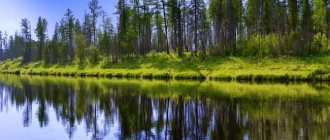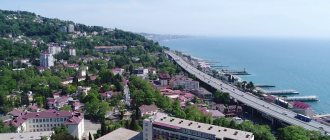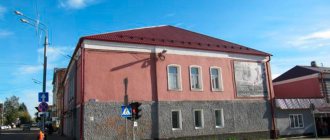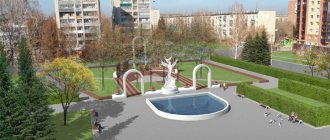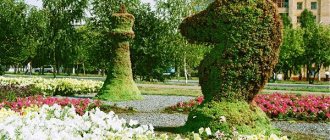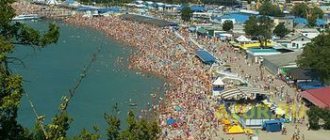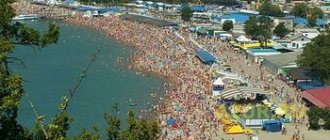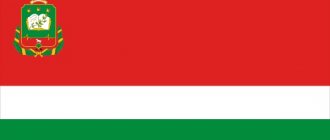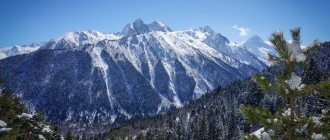Georgia is a colorful, distinctive country with an ancient, complex history that has left its mark on the architecture and created monuments that are admired by the modern generation. In addition to historically interesting sights, it is filled with spiritual sanctuaries and cultural centers created in different eras of development. All this is harmoniously combined with the latest buildings, sculptures and youth institutions.
Georgia is known for its extensive vineyards, winemaking, cognac production, unique culinary dishes popular throughout the world and natural cheeses. But its main attraction is its unique picturesque nature - located in the very center of the Caucasus ridge, with access to the waters of the Black Sea, it attracts travelers from all over the world. Everyone will find something to see in Georgia and, having been there once, will fall in love with this country forever.
What to do in Georgia
Georgia is a beautiful country with a developed tourism industry. Popular destinations include Tbilisi, Batumi, Mtskheta, Gori, Kutaisi. Millions of foreigners come to these cities to get acquainted with the history of the Georgian people, walk along the narrow stone streets and admire the temples, monasteries, fortresses, castles, and palaces.
Most often, guests combine excursions with participation in colorful celebrations, which help to appreciate local hospitality and explore the traditions and cultural characteristics of the country.
- In mid-October, the day of the ancient Georgian capital Mtskheta is celebrated.
- In June, Saint Nino is celebrated.
- In May - Queen Tamara.
- In July, a jazz festival starts in Batumi, bringing together foreign and domestic music connoisseurs.
- The national holiday of St. George, the patron saint of Georgia, is celebrated magnificently. All day long people burn bonfires, organize ceremonial processions and mass celebrations.
The autumn harvest festival in Kakheti is also popular. The region, famous for its vineyards, invites you to taste young wine. The ceremonial feast ends with dancing and fireworks.
Georgia, washed by the waters of the Black Sea, is an excellent resort with different options for beach holidays. In Batumi, Kobuleti, Kvariati - luxury hotels, fashionable parties, night clubs. The coastal zone, covered with round pebbles, is framed by coniferous trees and is considered the best for healing. In Ureki and Shekvetili, the beaches are strewn with magnetic dark brown sand. The gentle and smooth descent into the water warms up well and is suitable for small children.
Active recreation occupies an important niche in the country's tourism business. The slope of the South Caucasus Range stretches across the north of Georgia. The continuous mountain range attracts climbers and people with good physical fitness. For the ascent, routes have been laid out that take from one to several days. Along the way you can see local animals, visit mountain villages, explore caves, canyons and examples of old architecture.
Georgia is interesting not only in summer, but also in winter. In Gudauri there is a famous ski resort with hotels, high-speed slopes, ski lifts, and a cable car. Vacationers can rent equipment, use the services of an instructor, and enroll in a snowboarding and freeride school.
Abanotubani
Abanotubani is the central district of Tbilisi, famous since ancient times for its complex of sulfur baths. The architectural ensemble of buildings, into which water is supplied from underground sources, was rebuilt from the 17th to the 19th centuries. Thanks to them, the Georgian capital acquired its name: “Tbili” translates as “warm”. Since ancient times, sulfur baths, which are covered semi-basement buildings, have been valued for their medicinal properties.
Interesting places
Old Tbilisi
In the south-eastern part of Tbilisi is the historical heart of the city with narrow medieval streets and distinctive houses made of clay and brick. This is the tourist center of the capital, which contains architectural monuments dating from the 5th to the 19th centuries.
Old Tbilisi is crossed by the Kura River, dividing it into the Lower and Upper cities. Walking along the cobblestone streets, you can see fragments of the fortress walls, the Anchiskhati Church, the Sioni Cathedral, the palace of Queen Darijan, and the Norashen Temple.
Narikala
In Tbilisi, on the right bank of the Kura River, stands the Narikala defense complex, founded in the 4th century. The ancient building, which more than once repelled enemy attacks, was destroyed by time and the explosion of a gunpowder warehouse in 1827, and therefore needs restoration.
The outer fortress walls with round towers, soldiers' barracks, and outbuildings have been preserved. At the end of the last century, during excavations, the ruins of the Church of St. Nicholas of the 12th century were discovered. Now the church has been restored and welcomes believers. From Kura to Narikale you can climb on foot or take a cable car.
Mtatsminda
Tbilisi is decorated with Mount Mtatsminda, dominating the center of the capital. An amazing place, covered in myths, legends and glorified in Georgian folklore, is considered a symbol of the city. On the slope stands the Church of St. David. Nearby is the Mtatsminda pantheon with the burial places of national heroes, writers and scientists.
Hidden in the northern part of the mountain is Turtle Lake, near which there is an ethnographic museum. A park was planted at the top, a TV tower with a restaurant and several observation platforms were built. There is a hiking trail and a funicular to climb the mountain.
Petra
The ruins of the Byzantine fortress of Petra are located in the village of Tsikhisdziri near the seashore. Scientists believe that the fort was erected by order of Emperor Justinian I in the 6th century to protect trade routes from barbarians. It was a powerful stone citadel on a hill, but time has not been kind to it.
All that remains of its former grandeur are stepped terraces entwined with ivy, dilapidated external walls, the remains of baths and a basilica. The abandoned fortress is surrounded by greenery and looks mysterious and beautiful, which is why tourists come here to take original photographs.
Uplistsikhe
In the vicinity of Gori there is the ancient city of Uplistsikhe, carved into the rocks at the beginning of the 1st millennium BC. There are more than 150 caves, connected by grottoes and tunnels.
This place plays an important role in Georgian history. It was here that the first Christian churches appeared and, according to legend, Queen Tamara was crowned. The city, which existed for many millennia, fell into decay and was abandoned at the beginning of the 19th century.
It is now an archaeological site and tourist attraction. Living quarters, a wine storage facility, the Hellenic temple of Makvliani, and Christian rock churches are carved into the thickness of the rocks. Of interest is the pharmacy made of brick niches, inside of which traces of herbs and cosmetics were found.
Palace in Likani
Borjomi is decorated with a palace in the Moorish style, built for the Russian prince Nikolai Mikhailovich. The elegant villa stands proudly on a hill and is approached by a wide stone staircase. The two-story architectural complex is surrounded by a lush pine park.
There are alleys, lanterns and benches installed on the territory. The palace in Likani is the summer residence of the Georgian president. Since 2021, part of the villa has been converted into a museum. Visitors are shown personal belongings of members of the royal family, rare photographs, and antique furniture.
Rabat Fortress
The main monument of the southern city of Akhaltsikhe is the Rabat fortress of the 9th century. At first it consisted of bare rock protected by a stone wall. A little later, watchtowers, a castle, and a Christian monastery appeared in the courtyard. The defensive complex changed hands more than once, belonged to the Ottoman Empire for a long time and was seriously damaged.
A large-scale reconstruction in 2011 returned the fortress of Rabat to its formidable appearance. Experts restored a medieval Turkish mosque with a minaret, an Orthodox church, a courtyard, barracks, and an amphitheater. Part of the facility has been converted to serve tourists and houses a souvenir shop, hotel, and restaurant.
READ ALSO
TOP 24 best attractions in Tbilisi
Metekhi
The Metekhi district, located on the banks of the Kura River, is the center of historical Tbilisi. The first houses appeared here at the beginning of the 5th century, when the legendary king Vakhtang I Gorgasali erected his palace on the rock. An important landmark of Metekhi is the 12th century temple, built next to the royal palace. It is believed that Queen Tamara and other rulers of Georgia came to pray in this church.
In 1961, an equestrian sculpture of Vakhtang Gorgasali was installed on the square in front of the temple. And nearby there is a bridge across the Kura River connecting Old Tbilisi and Metekhi.
Old town of Tbilisi
The old district of Tbilisi, located at the foot of Mount Mtatsminda, is famous for its ancient temples and squares, built in the ancient traditions of Georgian architecture. Local residents are trying to preserve the old city in the form in which its ancestors left it from the time when it was still called Tiflis. This is where the excursion into the past begins. Tiny Georgian courtyards, narrow winding streets, carved balconies hanging over the streets, quaint facades of houses filled with the spirit of antiquity, numerous squares and shady parks - all this will open to the curious gaze of a tourist in the very heart of the capital.
Temples and monasteries
Sioni Cathedral
The main temple of Tbilisi was founded by Vakhtang I Gorgasal and named after the Holy Zionist Mountain. The famous Georgian kings Adarnase, Guram and representatives of the princely family of Orbeliani are buried there.
The restored complex has retained its medieval appearance. It includes the main temple, two three-tiered bell towers and a courtyard with a beautiful park. The walls of the cathedral are decorated with frescoes by the artist G. Gagarin. The main relic is the cross of St. Nino.
Temple of Bagrat
The temple, which appeared in Kutaisi during the reign of King Bagrat III, belongs to the Georgian Orthodox Church. Until 2001, the stone structure with a thousand-year history was in deplorable condition. Afterwards, restoration began, returning the attraction to its blooming appearance.
The temple with a blue roof is decorated with figured carvings, arches and columns. A huge bronze cross is installed on the dome, clearly visible from different points in Kutaisi. The interior walls are decorated with mosaics. Next to the church stands a three-tiered bell tower with a pointed dome.
Gelati Monastery
Near Kutaisi there is a medieval Gelati monastery, included in the UNESCO World Heritage List. The monastery, founded by David IV the Builder, includes the Cathedral of the Nativity of the Virgin, the churches of St. George and St. Nicholas, bell towers, monks' cells, and an academy.
Architectural monuments are decorated with frescoes depicting historical figures and biblical events. King David and other monarchs of Georgia are buried on the territory of the monastery. Pilgrims and tourists come to see rare icons, draw water from the holy spring and pray.
David-Gareja
Along the Georgian-Azerbaijani border there is a complex of cave monasteries dating back to the 6th century. The unique historical monument consists of 20 monasteries carved into the rocks. The main one is the Lavra of St. David, founded by Syrian monks.
The walls of prayer halls and monastic cells in the David Gareja monasteries are covered with original ornaments and quotations from the Bible in Georgian, Armenian, and Arabic. Many churches preserve ancient frescoes with portraits of rulers, including Queen Tamara.
READ ALSO
14 best attractions in Mtskheta
Svetitskhoveli
Mtskheta is decorated with the main cathedral of the Georgian Orthodox Church, dedicated to the Twelve Apostles. The cross-domed temple of the 4th century is a World Heritage Site. The facade with tiles, double pilasters and carved designs is a masterpiece of Caucasian architecture. The stone walls and ceiling are decorated with colorful frescoes and mosaics.
The cloak of the prophet Elijah is kept on the right side of the altar. According to legend, the robe of the Lord, brought by believers after the crucifixion of Christ, is also hidden in the walls of the temple. The complex is surrounded by fortified walls. In the courtyard there is a garden and a chapel, which is the tomb for the royal Bagration family.
Jvari
Jvari is another World Heritage Site in Mtskheta. This is a church and monastery of the 6th century, standing on a mountain in the place where Aragvi merges with the Kura River. A small square temple in the traditional Caucasian style is crowned with a wide octagonal dome. The façade is decorated with flat niches, relief ornaments and stone sculptures. In the courtyard there are monastic cells and farm houses.
It is believed that it was the Jvari monastery that M.Yu. Lermontov described in his poem “Mtsyri”.
Vardzia
Vardzia is a unique monastic complex carved into the tuff wall of Mount Erusheti. Construction of the monastery, which was conceived as a defensive fortress, began during the reign of King George III. The final work was carried out after the death of the monarch, when his daughter, the revered Queen Tamara, was on the throne. The cave rooms go almost 50 meters deep into the rock and 8 floors up. The interest of tourists is attracted by the temple built in honor of the Dormition of the Blessed Virgin Mary, located in the center of the monastery. The vaults of the monastery are decorated with fresco paintings, some of which are dedicated to the great king and his daughter.
Museums
Georgian Museum
Historical Museum named after. Simone Janashia in Tbilisi is one of the best in the country. It presents archaeological and ethnographic exhibits reflecting the original Georgian culture. Valuable items include locally minted gold coins, medieval icons, Persian-style jewelry, and stones with Urartian inscriptions.
A place of honor is occupied by the skull and lower jaw of hominids, found in 1991 in Dmanisi. These human predecessors lived 1.85 million years ago and are therefore considered the oldest hominids to have lived outside of Africa.
Museum of Art
The Museum of Fine Arts, which opened its doors in Tbilisi at the beginning of the last century, stores 140 thousand unique exhibits. The spacious halls host exhibitions of Georgian, European, Russian and Oriental art.
On the excursion they show manuscripts of famous Georgian poets, paintings, engravings by local artists, a sketch for I. Repin’s canvas “The Ceremonial Meeting of the State Council”. Artwork from the Qajar period is popular, including portraits of beautiful girls and Persian nobles.
Ethnographical museum
In a Tbilisi park not far from Turtle Lake, an ethnographic museum is located in the open air. It showcases 70 houses typical of different regions of Georgia.
Tourists can get acquainted with Caucasian architecture: see openwork wooden houses with thatched roofs, buildings with multifaceted domes, guard fortresses, mills, wineries, barns, medieval Christian churches. The houses contain furniture and traditional household items: spinning wheels, looms, knitting frames, handmade carpets.
Dadiani Palace
There is an elegant palace in Zugdidi, erected in 1840 for the Mingrelian rulers. The stone two-story Dadiani mansion in the Spanish style attracts attention with wide verandas, pointed arches, thin columns, and original towers on the roof.
In 1849, a museum was opened in the interior, presenting Georgian antiquities from the collection of the castle owners. The exhibitions include gold antique masks, items from the Tagilon treasure, Byzantine icons, medieval paintings and weapons. There is a garden with roses and exotic trees around the palace.
READ ALSO
20 best attractions of Pitsunda
Experimentorium
The science museum is the most unusual and interesting in Tbilisi. This is a great place for a family holiday, able to interest adults and children. Numerous exhibits that explain the laws of chemistry, physics and mathematics can be touched, thrown, taken apart and put back together.
During the hour-long excursion, visitors are given an interesting lecture, allowed to test endurance on an astronaut simulator and take part in scientific experiments. For those interested, educational quests, chemical and nitrogen shows, and master classes on making ice cream and marshmallows are available.
Abastumani Astrophysical Observatory
This scientific landmark of Georgia was founded in 1932 and became the first high-mountain observatory of the USSR. A visit to the observatory, located on the Caucasian Mount Kanobili, is available to anyone: you can get here using a cable car or car. Here the cosmic luminaries are clearly visible - the mountain climate is characterized by a stable and transparent atmosphere. The observatory also offers night excursions, where you can view celestial objects through a telescope.
Natural attractions and parks
Tusheti
The national park in the historical region of Tusheti covers an area of 960 km², covered with mountain ranges and forests. Juniper, pine, spruce, birch, rhododendron, and small speedwell grow here. The fauna is represented by mountain goats, chamois, wild boars, Anatolian leopards, hawks, and black grouse.
There are routes throughout the park for exploring natural attractions and observing animals. The protected area lies in a remote mountainous area. Until the Tushino highway was built, it was possible to get there only on foot or by helicopter.
Daryal Gorge
On the border of Russia and Georgia, east of Kazbek, there is the famous Daryal Gorge, glorified by artists, poets and travelers. It lies in the gorge of the Terek River next to the Georgian Military Road.
For 3 km, the riverbed is surrounded by rocks 1200 meters high. The fortress of Queen Tamara, the Kristinskoye Gorge, and the Gveleti Bridge hid in their shadow. The Daryal Gorge is called the gates of the Caucasus.
Nearby are the ruins of the medieval village of Gveleti - from them there is a path to the waterfall. A wide stream rushes down from a 25-meter height, scattering spray over a huge distance.
Bateti
The lake with the purest fresh water is located on the slope of the Trialeti ridge, rising to a height of 1313 meters above sea level. Bateti has an area of 0.02 km² and a depth of 12 meters.
Trout and Asia Minor newt are found in cold water. The picturesque shores are surrounded by coniferous trees. In the dense forest there are roe deer, squirrels, and wild boars. Tourists come to the lake to breathe the healing mountain air and admire nature.
Botanical Garden
In 1880, the largest botanical garden in Georgia was founded in Batumi. Its collection includes 5 thousand species of trees, shrubs and flowers brought from different climatic zones. Mediterranean, African, Australian, Asian, and European floristic departments are available to tourists.
The eucalyptus grove, garden of succulents and palm trees, and rose garden are popular. Batumi Botanical Garden is a beautiful corner of nature, which has comfortable alleys, secluded meadows, small streams and lakes.
Tbilisi Zoo
In 1927, the country's leadership allocated an area of 100 hectares in the Vere River gorge for the construction of a zoo. Animals from different countries and continents were settled among the picturesque forest. To provide them with good conditions, waterfalls, ponds, lawns, and rocks were equipped.
A tour of the zoo introduces adults and children to hippos, black swans, silver pheasants, elephants, leopards, penguins, and crocodiles.
Route options
If you are planning a trip to Georgia for the first time, tourism brings you pleasure and you want not only to lie on a pebble beach, but also to see the most interesting and beautiful corners of the country, experience new emotions, get acquainted with the customs of the local population, plunge into ancient history, travel route for seven days can be composed as follows:
- spend the first few days in Tbilisi, walking along the narrow streets, exploring the main attractions;
- spend the third day visiting ancient cities: walking around Mtskheta, Gori and Uplistsikhe;
- on the fourth day he will go towards the Georgian military road to see the majestic Kazbek;
- fifth-sixth day to taste the best wines of Kakheti, study the history and memorable places of the region;
- and leave the last day for yourself - buy souvenirs, leisurely enjoy the mountain views in silence, take photos of the sights of Georgia, finally go to a cafe and eat your favorite delicacies, pack your bags.
Another good option is suitable for those who are traveling to Georgia for a week in their own car:
- spend the first day in Stepantsminda (Kazbegi);
- the second - will go to see interesting places in Tbilisi and Mtskheta;
- spend the third day in Kutaisi;
- fourth - go to Kakheti;
- and the last two days will soak up the sunny embankment of Batumi.
You found out what to see in Georgia in a week, but if you only have three days, devote them to viewing the interesting things in Tbilisi.
When you come for four or five days, then you can combine a trip to Stepatsminda and the cave cities with Tbilisi, or go for a few days of wine tasting in Kakheti. Before your trip, read reviews from tourists, study travel websites, look at photos of travelers, booklets and advertisements - all this will help you decide which places to visit in Georgia and choose attractions that deserve attention. You also need to prepare in advance because some establishments require you to enter by appointment. For those who do not want to plan their own route, there are various excursion programs.
Georgia is a small country with an ancient history that has left a special, unique imprint - unique architectural values that are harmoniously located among high, majestic mountains and hospitable people. In a week you can travel around the main, most beautiful and most remarkable places, take many bright photographs, enjoy pristine nature, breathe fresh mountain air, drink several bottles of delicious wine with national dishes. Every corner of the country is original and special in its own way. Temples, cathedrals, churches, former chambers of kings, protective fortress walls create an indelible impression, take you back many centuries and amaze with their scale. I hope it is now clear to you what to see in Georgia and what to pay special attention to, let the trip be unforgettable.
Tsminda Sameba
The cathedral is called a symbol of “renewed Georgia”. The building was built in 2004. And during its construction, all the traditions of temple architecture that had developed over many centuries were observed. Money for the construction of the cathedral was allocated by rich Georgians and ordinary citizens. The area of Sameba is over 5000 square meters, and its walls can simultaneously accommodate up to 15 thousand people. The building is built in such a way that it can withstand any earthquake.
Mountain landscapes of Racha
Getting acquainted with the nature of Georgia must begin with the mountain range located in the historical part of the country at the headwaters of the Rioni River.
Admiring these landscapes and breathing in the purest mountain air, here you can take a break from the bustle of the city and enjoy the splendor of nature. Hospitable Georgians will offer to taste national Georgian dishes while sipping “Khvanchkara”.
Antique lovers can admire the stone carvings and frescoes of the Church of St. Nicholas, built in a mountain valley in the 11th century, or visit the synagogue, built in the classical Moorish style.
5
Narikala Fortress
The same age as Tbilisi, the Narikala fortress has long been considered the “heart and soul” of the Georgian capital and one of the most beautiful sights in all of Georgia. The thickness of its walls and the grandeur of the towers speak of the original – defensive – purpose of this massive structure, located in the lower part of the Holy Mount Mtatsminda. And in fact, the location of the fortress was chosen in such a way that on one side it would be protected by an impregnable mountain, and on the other by the narrow but swift Kura River. At first the citadel was called Shuris-Tsikhe (“Enviable Fortress”), and there really was something to be proud of. For example, a water supply system carried through canals and aqueducts to the uppermost buildings.
The Mongol conquerors renamed the fortress Naryn-Kala, and over time this name was finally assigned to the fortress. As the city territory expanded, the buildings of the citadel grew, descending lower and lower to the waters of the Kura.
Despite the grandeur of the fortification, this landmark of Tbilisi has been subjected to destruction and reconstruction more than once. The earthquake of 1827 also led to significant destruction of the fortress.
Currently, the Narikala complex has been supplemented by the restored St. George's Church, built in the 12th century, and a cable car has been built across the Kura from Rike Park to the Sololaki ridge, along which it is easiest to reach the fortress.
Alphabet Tower (Batumi)
This is one of the modern attractions of Georgia. The openwork tower, wrapped in a spiral with a ribbon with the letters of the Georgian alphabet printed on it, was built in 2012 on the Batumi embankment, in the Park of Miracles. Its height is 135 meters.
The tower looks especially magical after sunset, when it is illuminated by thousands of lights. At its spherical top there is an observation deck from which a breathtaking view of Batumi opens.
It is expected that in the future a television studio and an observatory will be located under the dome, but at the moment there is a coffee shop and a souvenir shop, as well as a restaurant serving Georgian cuisine.
Find out prices for tours in Batumi
Svaneti
If you want to get acquainted with pristine Georgia and learn its traditions, you need to visit Svaneti. It is believed that it was from this region that the formation of the Georgian state began, however, despite its antiquity, this region has not been spoiled by civilization. The symbol of Svaneti is the Svan towers, unique small fortresses built to protect against enemy attacks, hence another name for this wonderful land - “The Land of a Thousand Towers”.
Not so long ago, this region was cut off from Georgia, and until now it can be considered the most distant and inaccessible place. If you decide to get to Svaneti, be prepared for a long journey, but you will not notice the time spent on the road, since you will be surrounded by picturesque landscapes. Arriving at the place, you will receive a warm welcome and pleasant communication with local residents who have managed to preserve their centuries-old traditions.
Kakheti
Describing the beauty and splendor of the Caucasian country, one cannot fail to mention the unique region where, according to legends and historical documents, winemaking originated.
In Kakheti there is the town of Sighnaghi, where you can get married at any time of the day, since the city Wedding Palace is open around the clock, without breaks or weekends.
In addition, the Alazani Valley will amaze with its pristine beauty and vineyards. Here you can taste Georgian wine produced according to ancient recipes. And hundreds of Christian pilgrims annually come to the monastery of St. Nino, where the festival is held.
11
Bridge of Peace
The Peace Bridge is a unique architectural structure across the Kura River, it connects Old Tbilisi with Rike Park. The bridge is made of glass and seems airy; looking at it from afar, it seems as if it is floating above the city.
And how beautiful it is at night, in the light of many spotlights! The Bridge of Peace looks impressive against the backdrop of the ancient buildings of Old Tbilisi. It is worth a visit to appreciate the play of contrasts between old and modern buildings, and admire the stunning views from above while walking along the bridge.
And when you get hungry after a walk, you will discover a large selection of atmospheric cafes of national cuisine, where you can have a snack, relax a little and continue exploring this amazing country with renewed vigor.
Nokalakevi
You can see the city - Fort Nokalakevi, traveling from Tbilisi to Batumi. Walking through the territory of the fortress, you will be immersed in the atmosphere and mentally transported to ancient times, because you will be surrounded by the walls of the fortress itself, a tower with arches, and the ruins of a palace, which nature has generously decorated with wild plants. After visiting the fortress, you can refresh yourself by swimming in the Tekhura River, or, conversely, walk to the hot wells, there are some of those here too.
To get to the springs, you need to cross the pedestrian bridge from the fortress and move upstream of the Tekhura, about one and a half to two kilometers, reviews from tourists tell us.
Rustaveli Avenue
The avenue is not only the main street of the capital, but also its “face”. Here are located government buildings, residences, ministries and other institutions that play an important role in the political life of the country. In addition, hotels, cafes and shops are open here.
Pillar of Katskhi (Katskhi village)
This landmark of Georgia, which is one of the symbols of its western part - Imereti, is located far from significant tourist routes. But it’s worth seeing if only because the small church on top of a 40-meter limestone monolith looks truly unique.
This place was revered even before the advent of Christianity - there was a temple to the god of fertility. The church itself was probably built in the 6th–8th centuries. Believers came here because it was here that they could be closest to God. And starting from the 15th century, hermit monks offered prayers from here. When Türkiye invaded the region, the monastery was abandoned and fell into disrepair. It was restored in the 20th century.
Today all tourists can explore the complex from the foot of the cliff (there is a museum, a church, and guest houses), but climbing to the top is very difficult. Women are not allowed here, and men also need to collect many permits.
Kumistavi
One of the most beautiful caves in Georgia is also called “Prometheus Cave”. And it received such a name not by chance, because according to the mythology of Ancient Greece, in this cave in the Caucasus, Prometheus was chained to a rock for stealing fire from Olympus and giving it to people.
This cave was opened to tourists in 2011. Designers from Europe worked on its design, so when you enter the cave, you can truly appreciate the natural beauty combined with light and music.
Walking through the cave cannot be considered extreme tourism; on the contrary, it is useful for people with various diseases to be here, since the composition of the air contains a large percentage of pure oxygen. Walking through the cave, you will see stalactites and stalagmites, underground rivers and even a lake; you will discover natural beauties hidden under the thickness of the rock.
Dadiani Palace
The magnificent castle, located in the Georgian city of Zugdidi, the capital of the Megrelian principality, was built in the 19th century as the residence of Princess Catherine Dadiani. The architecture of the palace will not leave anyone indifferent: arched openings, graceful turrets, lancet windows, graceful stucco moldings, medieval ornaments - in all this one can feel the interweaving of strict English style and national Georgian features. On the territory of the palace complex there is a museum storing both ancient artifacts and exhibits of the 19th century. Around the palace there is a botanical garden consisting of rare representatives of the flora.
Martvili Canyon
It seems that nature used all its skill and talent, creating the mountain landscapes of Georgia. To see the beauty of the canyon you need to walk several hundred meters along the mountain river, or take a boat.
At the height, there are enchanting views of mountain lakes, waterfalls cascade from a 12-meter height, and all this water extravaganza is surrounded by rocky slopes hung with vines and other exotic plants.
The place is also unique in that during research, Georgian scientists discovered dinosaur prints in the canyon.
10
Gori
The city in the picturesque region of Georgia is famous for the fact that until 2010, on one of its squares there was the only monument to Joseph Stalin in the post-Soviet space. It was then moved to the museum.
Among other attractions, it is worth noting the medieval fortress of Goristsikhe, which is a kind of Kremlin of the ancient Georgian city.
The first mention of the unique fortress dates back to the 13th century, but the first settlements on the site of modern Gori, as archaeological excavations have shown, appeared in the first centuries of the 1st millennium.
6
Khertvisi
This fortress is located near the cave city of Vardzia. It is practically untouched by time, and its length is almost 180 meters. Thanks to its massive walls and interesting location, this fortress was a major military installation. It is located on a rock that divides the Kura River into two parts, which means that it was not at all easy for foreigners to attack the fortress. Now it looks spectacular from afar, fitting perfectly into the mountain landscape. Not far from the fortress there is a small village where you can relax, have dinner or stay overnight; you can find a more precise location of the recreation areas on the map in Russian.
Truso
Let's imagine another beautiful mountainous region of Georgia, where the Terek River has its source, and many mineral springs stretch along its banks.
In the valley you can feel the magnificent color contrast of green meadows with snow-white peaks against the backdrop of the deep Georgian sky. It is quiet and peaceful here, with only occasional small mountain villages.
Mountaineering lovers especially note the unique Trusovskoye Gorge, which is called the “Valley of Narzans” in many guidebooks. In addition to natural beauty, there are also historical monuments.
15
Alaverdi
Alaverdi Cathedral, or St. George's Cathedral. Representative of classical temple architecture of Georgia. From the outside, the cathedral looks quite simple, but the interior is pleasing to the eye with its numerous paintings and frescoes. This is a working monastery, majestic and strict. The cathedral is located near the main highways, so visiting it is ideal for road trips.
Cable cars of Chiatura
Chiatura is an industrial city in Georgia that specialized in manganese mining in the USSR. After the collapse of the mighty union, the city was empty, but recently a flurry of tourists has not bypassed it. After all, it was here in 1954 that the first cable car capable of carrying passengers was built. This unusual type of transport brought residents to hard-to-reach mountain areas and helped in the transportation of minerals. The cable car cabins and stations have not been changed since their construction. Such a journey will seem extreme to many: the slope reaches 48 degrees.
Borjomi
The central Georgian resort of Borjomi, protected by the Caucasus Mountains, is characterized by a mild and favorable climate. This natural landmark of Georgia is famous for its healing water springs, which were used for medicinal purposes long before our era. The imperial couple of the Romanovs came here, and the people's leader I.V. Stalin rested here. Borjomi is famous not only for its crystal clear waters, but also for its gorge, rich in flora and fauna, a city recreation park, and architectural complexes, including the palace of the Romanov Tsars and the house of Mirza Riza Khan.
